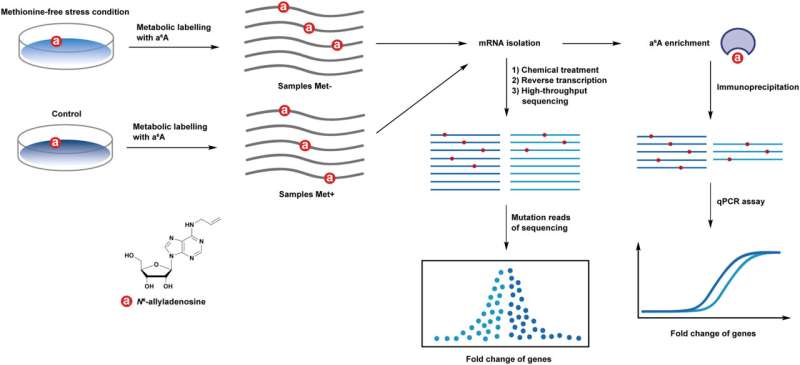Nucleoside analogs for messenger RNA metabolic labeling and sequencing
by KeAi Communications Co.

High-throughput RNA-sequencing (RNA-seq) is widely used to profile global cellular gene expression and gain insights into cellular biological processes; however, effectively tracking dynamic changes in cellular mRNA expression remains a challenge. Being able to do so can help researchers to investigate transcripts over a time frame.
In a study published in the journal Fundamental Research, a team of researchers has pioneered a novel method. It incorporated an adenosine analog, N6-allyladenosine (a6A) into newly transcribed RNAs by nucleoside salvage pathways.
Following the metabolic labeling, the researchers employed a chemical iodination treatment to convert a6A within the transcripts into a distinct variant structure. This modified structure can then be accurately identified as base mutation sites using high-throughput sequencing technology.
“We believe that an increasing number of nucleoside analogs will be explored for uses as chemical sequencing tags with the hope of achieving specific labeling on different kinds of RNA, especially mRNA,” says Jianzhao Liu, corresponding author of the study, and a professor at the Institute of Biological Macromolecules at Department of Polymer Science and Engineering of Zhejiang University.
The team found that a6A can be recognized by RNA polymerase and incorporated into the newly synthesized cellular mRNA. Meanwhile, the allyl group on a6A is bio-orthogonally treated with iodine and a6A is converted into a structure of 1,N6-cyclized adenosine. Consequently, this modification induces base mismatch during RNA reverse transcription, leading to the generation of A- to C/T mutation reads in subsequent RNA-seq analysis.
At present, an antibody suitable for the immunoprecipitation of a6A-containing RNA is commercially available. Leveraging these resources, the researchers used a6A in their investigation of alterations in cellular gene expression profiles under methionine-free conditions. Furthermore, they utilized a6A-IP as a validation tool to confirm the findings obtained through sequencing. This integrated approach allowed for comprehensive and reliable analysis of gene expression dynamics.
“Our technique will enable researchers to track the newly formed a6A-containing transcripts and investigate the dynamics of these transcripts, including RNA synthesis and decay,” says Liu. “a6A provides not only a chemical tag for sequencing, but also a tag for antibody enrichment.”
More information:
Xiao Shu et al, a6A-seq: N6-allyladenosine-based cellular messenger RNA metabolic labelling and sequencing, Fundamental Research (2023). DOI: 10.1016/j.fmre.2023.04.010
Provided by
KeAi Communications Co.
Citation:
Nucleoside analogs for messenger RNA metabolic labeling and sequencing (2023, June 21)
retrieved 21 June 2023
from https://phys.org/news/2023-06-nucleoside-analogs-messenger-rna-metabolic.html
This document is subject to copyright. Apart from any fair dealing for the purpose of private study or research, no
part may be reproduced without the written permission. The content is provided for information purposes only.
For all the latest Science News Click Here
For the latest news and updates, follow us on Google News.

